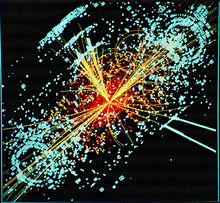| Beyond the Standard Model | ||||
 | ||||
Standard Model
|
A theory of everything (TOE) is a putative theory of theoretical physics that fully explains and links together all known physical phenomena, and predicts the outcome of any experiment that could be carried out in principle.
Initially, the term was used with an ironic connotation to refer to various overgeneralized theories. For example, a great-grandfather of Ijon Tichy—a character from a cycle of Stanisław Lem's science fiction stories of the 1960s—was known to work on the "General Theory of Everything". Physicist John Ellis[1] claims to have introduced the term into the technical literature in an article in Nature in 1986.[2] Over time, the term stuck in popularizations of quantum physics to describe a theory that would unify or explain through a single model the theories of all fundamental interactions and of all particles of nature: general relativity for gravitation, and the standard model of elementary particle physics — which includes quantum mechanics — for electromagnetism, the two nuclear interactions, and the known elementary particles.
The theory of everything is also called the final theory.[3] Many candidate theories of everything have been proposed by theoretical physicists during the twentieth century, but none has been confirmed experimentally. The primary problem in producing a TOE is that general relativity and quantum mechanics are hard to unify. This is one of theunsolved problems in physics.
No comments:
Post a Comment